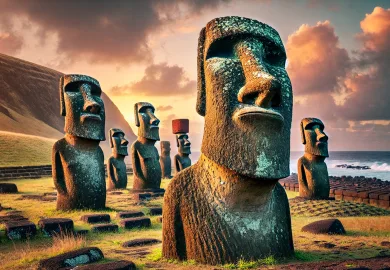
The Germanic tribes have long captivated historians and enthusiasts alike, offering a glimpse into a world of fierce warriors, complex societal structures, and rich cultural traditions. Emerging from the misty forests of Northern Europe, these tribes played a significant role in shaping the history and culture of Europe as we know it today. From their warrior ethos to their intricate mythology, the Germanic tribes left an indelible mark on the continent, influencing everything from language to law.
Origins and Spread of the Germanic Tribes
The origins of the Germanic tribes trace back to the first millennium BCE when they began to emerge as a distinct group in Northern Europe. These early Germanic peoples occupied areas of present-day Denmark, Germany, Sweden, and Norway. As they grew in number and power, they expanded southwards, encountering the Roman Empire, with whom they had a complex relationship of both trade and conflict.
The spread of the Germanic tribes across Europe was not a sudden event but rather a gradual process of migration and conquest. Driven by a combination of overpopulation, climate change, and the allure of the wealthier Roman territories, these tribes moved into what is now modern-day France, Italy, Spain, and beyond. Some of the most famous Germanic tribes, such as the Visigoths, Ostrogoths, Vandals, and Lombards, would go on to play pivotal roles in the fall of the Western Roman Empire.
These migrations were not merely military campaigns but also involved the establishment of new settlements, the assimilation of local cultures, and the development of new political entities. The Germanic tribes were not a monolithic group; they consisted of various distinct tribes, each with its own customs, dialects, and leadership structures. However, they shared certain cultural traits that would later influence the broader European culture.
The Warrior Culture: A Society Built on Honor and Combat
The Germanic tribes were renowned for their warrior culture, which was deeply embedded in their society. From a young age, Germanic boys were trained in the arts of war, learning how to handle weapons, ride horses, and engage in combat. This training was not merely for defense but was also seen as a way to gain honor and prestige within the tribe.
In Germanic society, warriors were highly respected and often held positions of power. The concept of “comitatus,” a bond between a lord and his warriors, was central to their social structure. This bond was based on mutual loyalty and the promise of protection, with the lord providing his warriors with weapons, food, and shelter in exchange for their service in battle.
Combat was not only a means of survival but also a way to achieve glory. Warriors sought to distinguish themselves in battle through acts of bravery and skill, earning the admiration of their peers and the favor of the gods. The idea of dying a heroic death in battle was deeply ingrained in the Germanic warrior ethos, with the belief that such a death would secure a place in the afterlife among the gods.
Weapons were highly valued in Germanic culture, often being passed down through generations as treasured family heirlooms. Swords, axes, and spears were not only tools of war but also symbols of a warrior’s status and identity. Many Germanic tribes practiced the ritual of burying their dead with their weapons, a testament to the importance of the warrior in both life and death.
Germanic Mythology and Religion: The Spiritual World of the Tribes
The religious beliefs and practices of the Germanic tribes were deeply intertwined with their daily lives and warrior culture. Germanic mythology was rich with gods, goddesses, and supernatural beings, each of whom played a significant role in the lives of the people.
At the center of Germanic religion was Woden (or Odin), the chief of the gods, who was associated with war, wisdom, and death. Woden was revered as the god of warriors, and many Germanic tribes believed that he would choose the bravest of the fallen warriors to join him in Valhalla, the hall of the slain, where they would prepare for the final battle at the end of the world.
Another prominent deity was Thor, the god of thunder, who was seen as the protector of mankind and the gods. Thor was often depicted wielding his mighty hammer, Mjolnir, with which he defended the world from giants and other malevolent forces. His popularity among the Germanic tribes was widespread, and many warriors invoked his name before going into battle.
The Germanic tribes also worshiped a host of other deities, including Freyja, the goddess of love and fertility, and Tiwaz (or Tyr), the god of law and justice. These gods were often honored with sacrifices and rituals, which were performed in sacred groves, mountains, or near bodies of water, all of which were considered holy.
In addition to their pantheon of gods, the Germanic tribes believed in a variety of supernatural beings, such as elves, dwarfs, and spirits, who inhabited the natural world. These beings were often associated with specific places, such as forests, rivers, and mountains, and were both revered and feared by the people.
The afterlife was an important concept in Germanic religion, with the belief that the soul would continue to exist in another realm after death. The nature of the afterlife was thought to depend on how a person lived their life, with warriors being rewarded with a place in Valhalla or Folkvangr (Freyja’s hall), while others might find themselves in Hel, a realm of the dead ruled by the goddess of the same name.
The Social Structure and Daily Life of the Germanic Tribes
The social structure of the Germanic tribes was hierarchical, with a clear division between the nobility, free men, and slaves. At the top of the hierarchy were the chieftains or kings, who ruled over the tribe and were often chosen from among the nobility. These leaders were expected to be both capable warriors and wise rulers, able to protect their people and make important decisions.
Below the chieftains were the free men, who formed the backbone of Germanic society. These were the warriors, farmers, and craftsmen who owned land and had the right to participate in the tribe’s assemblies, where decisions about war, law, and other matters were made. The free men were expected to contribute to the defense of the tribe and to support their leaders in times of need.
Women in Germanic society also played important roles, particularly in the household and in religious practices. While they were generally excluded from warfare, women were respected for their roles as mothers, wives, and keepers of the home. In some tribes, women could also hold significant religious positions, such as priestesses, and were believed to possess special knowledge of the gods and the supernatural.
At the bottom of the social hierarchy were the slaves or thralls, who were typically captives taken in war or individuals who had fallen into debt. Slaves were considered the property of their masters and had little to no rights within the tribe. However, in some cases, slaves could earn their freedom through loyal service or by being granted it by their masters.
Daily life in Germanic tribes was centered around the household, which often consisted of extended families living together in longhouses. These homes were constructed from wood and thatch, with a central hearth that provided warmth and a place for cooking. The Germanic people were skilled farmers, raising crops such as barley, oats, and wheat, and keeping livestock such as cattle, sheep, and pigs.
Craftsmanship was also highly valued in Germanic society, with skilled artisans producing weapons, tools, jewelry, and textiles. Trade was an important aspect of life, with the Germanic tribes engaging in both local and long-distance trade with neighboring peoples, including the Romans.
Festivals and feasts were common in Germanic society, often held to mark important events such as harvests, victories in battle, or religious ceremonies. These gatherings were occasions for the tribe to come together, share food and drink, and strengthen social bonds.
The Legacy of the Germanic Tribes: Impact on European Culture
The influence of the Germanic tribes on European culture is profound and far-reaching, leaving a legacy that can still be seen today in various aspects of modern life. One of the most significant contributions of the Germanic tribes is their impact on the development of the languages of Northern Europe. Many of the languages spoken today in Scandinavia, Germany, and the British Isles have their roots in the Germanic languages spoken by these ancient tribes.
The Germanic tribes also played a crucial role in the formation of medieval European states. As the Roman Empire declined, many Germanic tribes established their own kingdoms, some of which would become the foundation for modern European nations. For example, the Franks, a Germanic tribe, laid the groundwork for what would become France, while the Anglo-Saxons, who were of Germanic origin, were instrumental in the formation of England.
In addition to their linguistic and political influence, the Germanic tribes also contributed to the legal and cultural traditions of Europe. The concept of trial by combat and the idea of wergild (a system of compensation for crimes) are both rooted in Germanic legal practices. These concepts would later influence the development of European legal systems during the Middle Ages.
Germanic mythology and folklore have also left a lasting imprint on European culture. Many of the stories and characters from Germanic mythology, such as the gods Odin and Thor, continue to be popular in literature, art, and modern media. The themes of heroism, fate, and the struggle between order and chaos that are central to Germanic mythology continue to resonate in Western culture.
The architectural and artistic styles of the Germanic tribes, particularly in their metalwork and jewelry, have also influenced European art. The intricate designs and patterns found in Germanic artifacts, such as brooches, swords, and helmets, reflect a high level of craftsmanship and artistic expression that has inspired later artistic movements in Europe.
In conclusion, the Germanic tribes were a dynamic and influential group that played a crucial role in shaping the history and culture of Europe. Their warrior ethos, religious beliefs, social structure, and cultural practices left a lasting legacy that continues to be felt today. Whether through their contributions to language, law, or mythology, the Germanic tribes have left an indelible mark on the fabric of European civilization.








